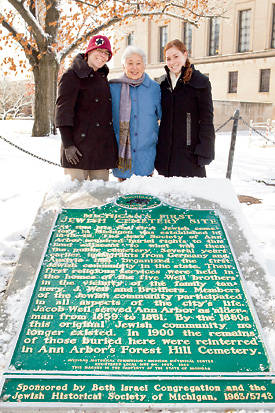Jewish community leaders and U-M officials say they’re pleased following the successful replacement of a damaged historic marker that commemorates the site of the state’s first Jewish cemetery.
The metal plaque at the corner of East Huron and Fletcher streets on the U-M campus was found broken in two pieces shortly after 2 a.m. July 10. A replacement marker was placed at the end of October.

Tilly Shames, associate director of Jewish campus organization Hillel, left, joins Helen Aminoff, a member of Beth Israel Congregation in Ann Arbor, and Hillel leader Miriam Goldberg, a Syracuse, N.Y., junior in the School of Education, at the new historic marker replacing a plaque found damaged in July. The marker commemorates the site of the first Jewish cemetery in Michigan. Photo by Scott Soderberg, U-M Photo Services.
University Planner Susan Gott says that soon after the university was informed of the damaged marker, the Michigan Historical Center was contacted to determine the proper procedure to replace it. University departments that managed the effort included the University Planner’s Office, Plant Operations and the Risk Management Office.
A new base was created to increase the angle of the marker, to better withstand weather; it was paid for through contributions. The marker’s inscription was unchanged.
“It was important to replace the historic marker because we want to honor the history and the legacy of what the marker commemorates,” Gott says. “We were pleased to be able to facilitate the replacement so quickly in order to maintain continuity and preserve the historical record.”
Tilly Shames, associate director of Jewish campus organization Hillel, says she also was pleased that the marker was restored quickly. “We at Hillel are very proud that this historic site for the Jewish community and Ann Arbor community is a part of our campus,” Shames says.
The marker was dedicated June 12, 1983. It celebrates the first Jewish cemetery in Michigan, established in 1848-49 after the Jews Society of Ann Arbor acquired burial rights to land adjacent to a public cemetery. Several years earlier, immigrants from Germany and Austria had organized the first Jewish community in the state. By 1900 the remains of those buried there were reinterred in Ann Arbor’s Forest Hill Cemetery.
“While we were very disturbed about the vandalism we were really encouraged by the amount of community cooperation that came together to get this done so quickly,” says Aimee Ergas, director of the Jewish Historical Society of Michigan. “This is an important marker for Ann Arbor and for Jewish history and we’re glad it’s available to the public again.”
While the university offered a reward for information regarding the vandalism, no tips were received, says Diane Brown, Department of Public Safety public information officer. She says the investigation remains open.

